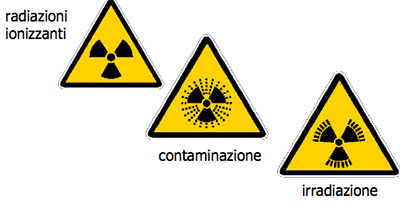Use of sources of Ionising Radiation

X-rays are produced by artificial sources of radiation (X-ray machines). Gamma rays are, instead, generated by the decay of radioisotopes: atoms that spontaneously emit ionising radiation. During this decay process the nucleus of one element is transformed into the nucleus of another element or changes to a lower-energy state.
Sources of ionising radiation can be divided into:
- X-ray machines that, by accelerating charged elementary particles (e.g., electrons) generate radiation beams (e.g., X-rays);
- Sealed sources, where the radioactive material (radioisotopes) is sealed in an inactive capsule strong enough, under normal conditions of use, to prevent the dispersion of radioactive material exceeding the limits established by the applicable technical standards. Unsealed sources are radioactive substances that are not a sealed source.
NB: Sealed and unsealed sources do not only emit gamma rays, but can emit charged particles such as protons, electrons, alpha particles that can ionise human tissue.
When there are sources of ionising radiation in the workplace, the ionising radiation risk assessment must be carried out by the Qualified Radiation Protection Adviser appointed by the Dean.
The Qualified Adviser:
- Designs the workplaces, any safety barriers and signage and defines the procedures that must be followed so that the exposure of workers and, where applicable, members of the public, is kept to a minimum;
- limits the number of people who are exposed, insofar as compatible with work requirements;
- limits the exposure time of workers;
- assesses the level of exposure of workers using environmental and/or staff monitoring tools.
The Qualified Adviser classifies workers as exposed or not exposed, taking into account the job description as stated by each worker, by the Department Manager and by the Person in charge of the activity and according to the types of sources used to perform the job, and also classifies the working environments so that: exposed workers undergo appropriate physical monitoring and health surveillance and access to the working environments in question is restricted, controlled and recorded.
IMPORTANT: WHAT TO DO when you intend to purchase or dispose of a new source of ionising radiation or move it to another laboratory
Any changes in respect of the original information concerning radiological practices at PoliTO provided to the Supervisory Bodies (e.g., regarding the purchase or disposal of equipment, changes in equipment work loads and/or location, use of premises where radiological equipment is installed and adjacent areas, sale or loan of equipment to other Departments, changes to staff appointed/authorised to use radiation sources) must be reported in advance, via the Health and Safety Services Unit (PREP), to the Qualified Adviser, so that the latter can define all the appropriate procedures to ensure compliance with the regulations in force.
